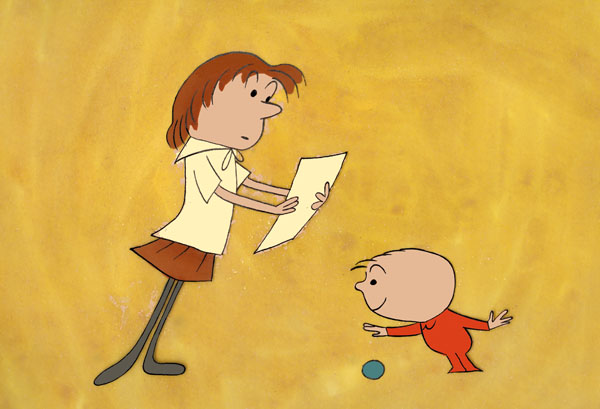
Text below is excepted from an interview with Gene Deitch by Gary Groth via telephone in 2008; transcribed by Sam Schultz – reviewed and updated in Spring 2019 by Gene Deitch. Reprinted with Gene’s permission.
Gary Groth: (Producer) Bill Snyder struck me as a lovable rogue.
Gene Deitch: Yes. He was a lovable rogue. I think that’s Bill Snyder, all right.
Groth: Now briefly, he cajoled you into going to his animation studio in Prague for what was going to be a short stint, correct?
Deitch: Yes. When I finally agreed to go I said I’ve got to have a contract in black and white that says I don’t have to stay more than 10 days.
Groth:What was the specific project you were going to be doing over there?
Deitch: What he wanted me to do was to help him correct some films that he had in work here with Zdenka. The reason I accepted was because he also agreed, that if I would come, he would finance the production of Munro and one other project that I had created with my best friend in New York, Allen Swift, called Samson Scrap and Delilah.
Jules Feiffer was working for me. He had created the storyboard for Munro. His Munro storyboard was on my studio office wall, and was almost getting brown with age, waiting for somebody to come in and back it. So of course, when Snyder said that he would finance Munro, that was the offer I couldn’t refuse.
Groth: Munro had been published as a comic.
Deitch: As a book. It was one of the graphic stories in a book called Passionella and Other Stories. That was the first thing that Jules had been able to get published. He’d been working on that story, moonlighting, when he was on my staff at Terrytoons, but he managed to do it off-hours so it didn’t fall into the clutches of Terrytoons. That was really a piece of luck; so the story was ready, and he owned the copyright. I had a great guy on my GDA staff named Al Kouzel who became friendly with Jules. He was able to be a great help in adapting Munro into a working storyboard. Eventually, Jules made the storyboard himself, and then Al Kouzel made the production layouts. I was really very close to being able to get Munro into production. All I needed was the money. Getting to the storyboard stage didn’t cost very much.
(click thumbnails below to enlarge)
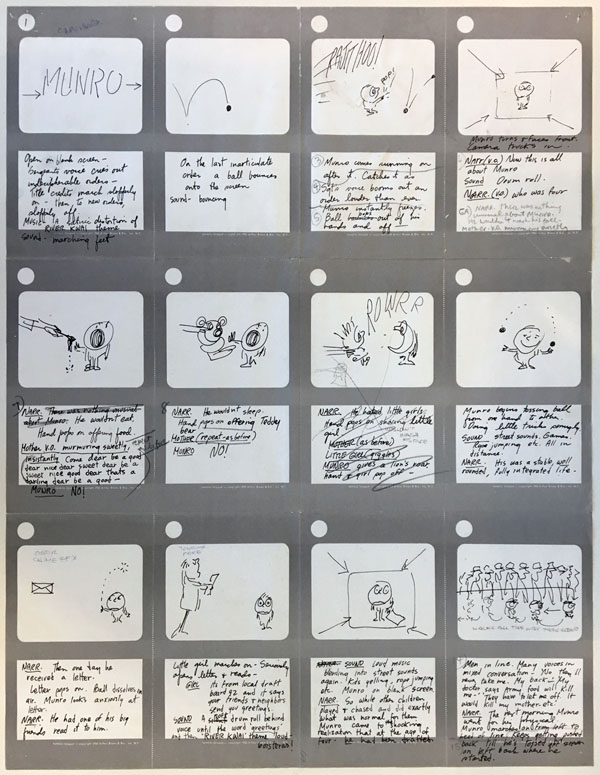
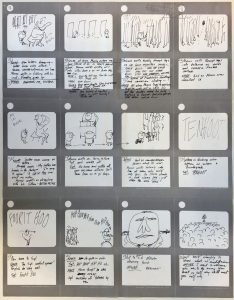
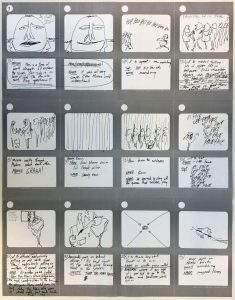
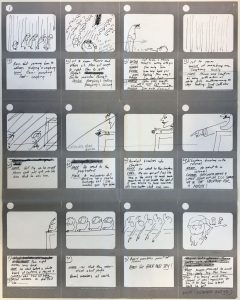
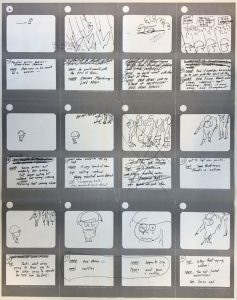
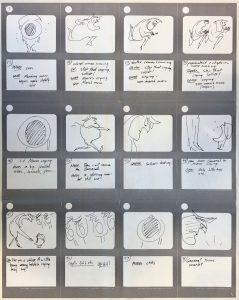
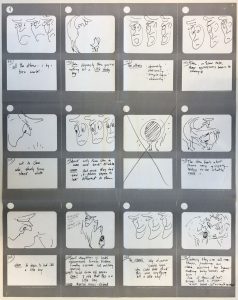
Groth: How long a movie was it? About nine minutes?
Deitch: I don’t think it’s that long. I can’t remember, but I don’t think it was more than six or seven minutes at most. Have you seen it?
Groth: Yes, I have. Visually, the animated cartoon hones very much to Jules’ cartooning.
Deitch: Oh, yeah. Of course, the one thing that I was trained in at UPA is following whatever graphic style was right for each story. If we adapted a children’s book, we wanted to make it look exactly like the book. And I’m doing that ’til this very day. That’s the basis of my work. I’ve learned how to recreate anybody’s drawing style. I keep telling people there’s no such thing any more as a Gene Deitch style. You saw my personal styling in Terr’ble Thompson and The Cat, and Nudnik, but nowadays, very, very rarely do I ever get a chance to make a film in my own style, because what I’m paid to do 99% of the time is to adapt a children’s picture books.
To do that, I have to learn the “handwriting” of the illustrator of each book. And, you know, I learned the handwriting of Jules and was able to draw his characters exactly like he did. It’s my specialty.
Groth: Now Gene, let me ask you a question about that. That seems like a serious trade-off.
Deitch: It is.
Groth: You can get some satisfaction by imitating some else’s…
Deitch: I do. Not many animators today feel that way. But if you think about it, every animator in every major animation studio, must conform to the studio’s “house” style! Feature animation movies have many animators, and all must work as members of a team, basing their drawings on the official model sheets, and are kept in team unity by the director. Animators dream of doing their own things, and sometimes get the chance, on small projects.
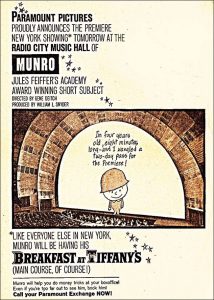 Groth: Where did the seven or eight minute Munro appear?
Groth: Where did the seven or eight minute Munro appear?
Deitch: It was a theatrical cartoon. It was also distributed by Paramount, and it opened with great fanfare, coupled with “Breakfast at Tiffany’s at the enormous Radio City Music Hall in New York.
Groth: Munro won the Oscar in 1961. That must have been enormously gratifying.
Deitch: Of course it was. And it was a tremendous surprise because I didn’t bother to fly to LA for the ceremony. Bill Snyder accepted the Oscar on the TV broadcast, because he was the nominal producer. In those days, and still today, the Oscar for a short film goes to just one person. Snyder simply entered Munro on his own as if he had made it, and it won. So my Oscar has his name on it. That’s the truth.
Groth: In making Munro, I believe, you used Seth’s voice.
Deitch: Yes. Seth was 3 years old at the time. I had an early home tape recorder at the time, as I mentioned before, and I followed him around with a microphone and I said, “Now Seth, say ‘I’m only 4, I’m only 4!’” And he said, “But Daddy, I’m only 3. I can’t lie.” He was only 3 years old. So I said, “I know you’re only three, but this is make-believe. Say ‘I’m only 4.’ It took a lot to get him to do that, but he did say it. He could even pronounce the name “Czech-o-slo-vakia” at the age of three. He was an early speaker, and had a charming voice. As far as I’m concerned, he made the film!


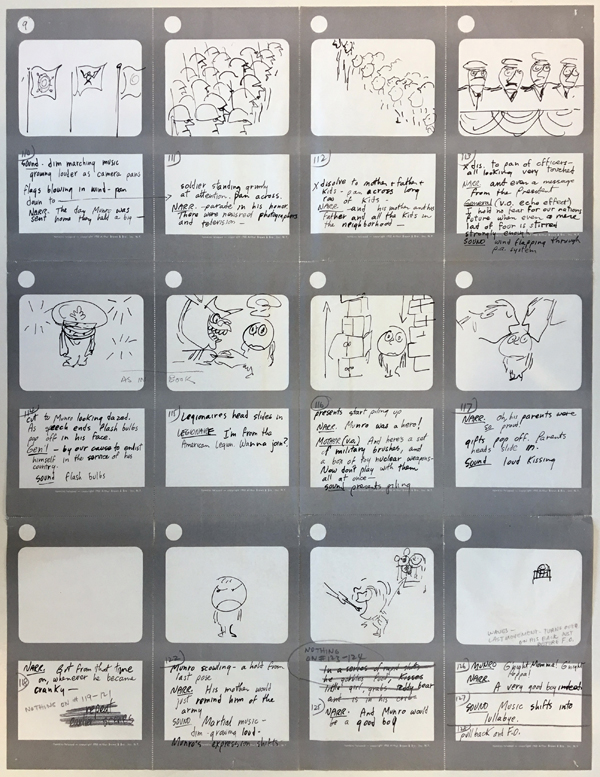
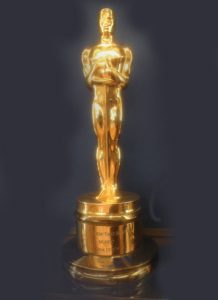
 Gene Deitch is a cartoonist and Oscar winning animator who created such beloved characters as Tom Terrific, Silly Sidney and Nudnik. Gene was the director of UPA New York, the creative supervisor at Terrytoons (1956-58) and the acclaimed producer of hundreds of shorts for Weston Woods. He passed away April 17th, 2020, in Prague.
Gene Deitch is a cartoonist and Oscar winning animator who created such beloved characters as Tom Terrific, Silly Sidney and Nudnik. Gene was the director of UPA New York, the creative supervisor at Terrytoons (1956-58) and the acclaimed producer of hundreds of shorts for Weston Woods. He passed away April 17th, 2020, in Prague.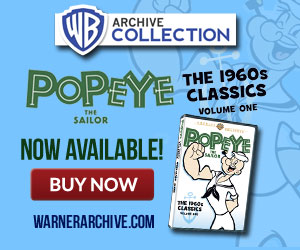











































I’m glad you’ve been able to take satisfaction in working within the artistic styles of other illustrators, and you’re quite right that all animation studios do this to some extent. I’ve seen your adaptations of Maurice Sendak’s books and think it must have been very rewarding to capture his complex and individualistic style.
I recall reading an excerpt from a letter that E. B. White wrote to you, expressing his disappointment with the Hanna-Barbera production of Charlotte’s Web and regretting that you had not taken on the project instead. So there must have been some discussion of this before H-B acquired the film rights.
Did your studio ever create any preliminary concept art for a Charlotte’s Web feature, and would it have been based on the illustrations of Garth Williams from the original edition of the novel?